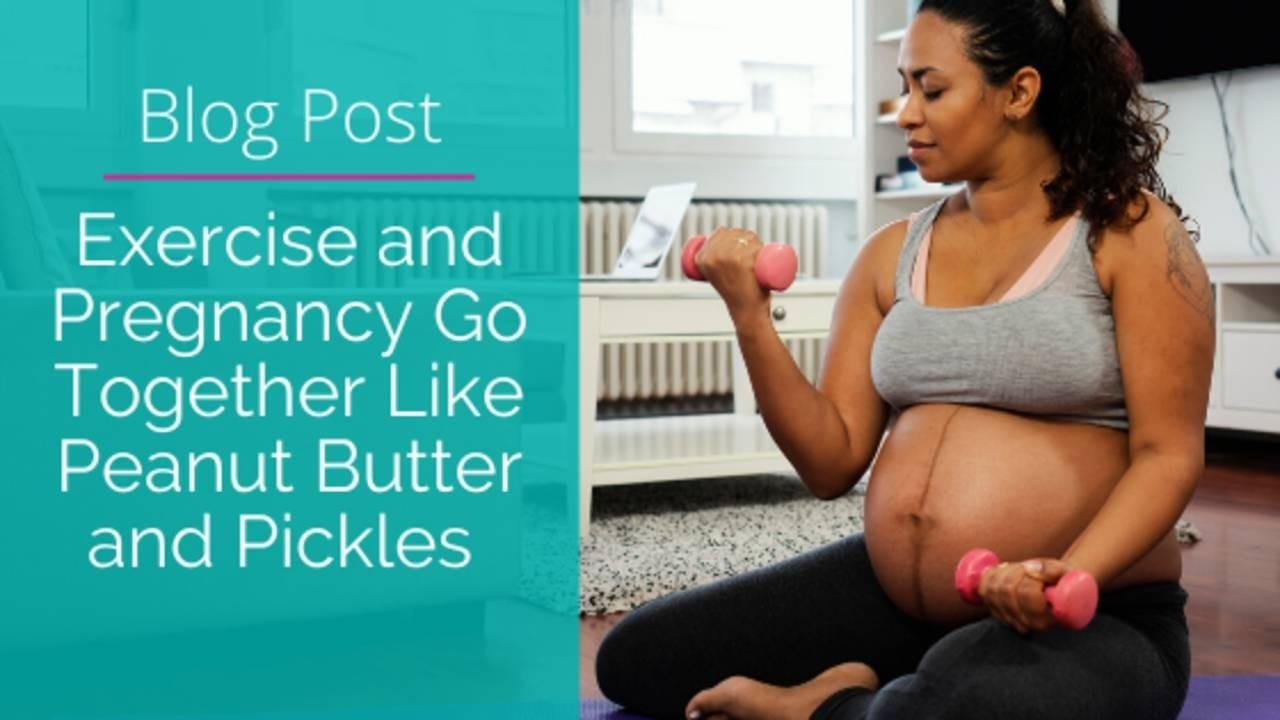Exercise and Pregnancy Go Together Like Peanut Butter and Pickles

What if I told you there was a magic “elixir” with no side effects that you could take in pregnancy that might help reduce backaches, constipation, bloating, and swelling.
It may help prevent or even treat gestational diabetes.
While it could increase your energy, it will also help you sleep better at night.
Oh, and it will decrease your chances of requiring a Cesarean section, may decrease your postpartum recovery time and prevent depressive episodes in the postpartum period? Would you try it out?! That is exactly what the American College of Obstetricians and Gynecologists is saying the effect of exercise is in their most recent Committee Opinion Statement released in April of 2020.
Exercise is defined as “physical activity consisting of planned, structured, and repetitive bodily movements done to improve one or more components of physical fitness.” We’ve all heard the advice given to athletes and other previously active pregnant women that “if you were doing it before pregnancy it’s generally safe to continue with some modifications during pregnancy.” But what about those women who were sedentary or not regularly active? Where does this leave them?
In the absence of medical or obstetric complications, it is recommended that OBGYNS and other obstetric care providers encourage patients to continue or commence exercise. In other words, pregnant women should initiate safe physical activity even if they weren’t significantly active prior to the pregnancy. Keep in mind that physical inactivity is the fourth leading risk factor for early mortality worldwide and that, along with excessive weight gain, is a risk factor for pregnancy complications related to obesity including diabetes mellitus.
So it’s settled! Now, where should you start? Considering the cardiovascular and hormonal changes that accompany growing another human inside you, there’s certain exercises to avoid including:
- High contact
- Ones that might cause a loss of balance
- Extremes of temperature
- Quick position changes
- Lying supine for long periods
- Asymmetrical forces on your joints
- Overstretching
- Increased strain on the connective tissue of your abdominal wall
- Increased pressure on the pelvic floor muscles
Don’t panic!!! There’s plenty of nutritious moves you can flock towards including ones that keep your Rating of Perceived Exertion (RPE) between 11 and 13 (somewhat hard, an effort, but you can still talk through), symmetrical moves that focus on deep abdominal and pelvic floor strengthening and relaxation, gentle stretching, postural muscle activation, as well as lengthening and space-creating movements.
As a Pilates instructor I know I am biased, but as a Prenatal Pilates Specialist I can tell you that modifying a regular Pilates sequence checks all of the boxes above and more! The principles of Pilates are centering, coordination, control, breath, precision, and flow. Honoring these principles and making small tweaks to limit the strain on the abdominals and pelvic floor, avoiding excessive position changes, and building in some additional gentle stretching is a wonderful way to prepare your body for birth whether you are a seasoned athlete or a mere acquaintance to regular exercise. Do you want an expert to gently guide you through a modified Pilates program designed with your pregnant body in mind? My programs are a combination of education and exercise and are available as self-paced online classes, personally led virtual sessions, private one on one sessions, and even group classes. Learn more at www.carriekoziol.com
SOURCES:
1. Obesity in pregnancy. Practice Bulletin No. 156. American College of Obstetricians and Gynecologists [published erratum appears in Obstet Gynecol 2016;128:1450]. Obstet Gynecol 2015;126:e112–26.
2. Dye TD, Knox KL, Artal R, Aubry RH, Wojtowycz MA. Physical activity, obesity, and diabetes in pregnancy. Am J Epidemiol 1997;146:961–5.
3. Artal R. The role of exercise in reducing the risks of gestational diabetes mellitus in obese women. Best Pract Res Clin Obstet Gynaecol 2015;29:123–32
4. World Health Organization. Global recommendations on physical activity for health. Geneva: WHO; 2010. Available at: http://www.who.int/dietphysicalactivity/publications/9789241599979/en.
5. Physical Activity and Exercise in Pregnancy and the Postpartum Period, No. 804, American College of Obstet and Gynecol April 2020

